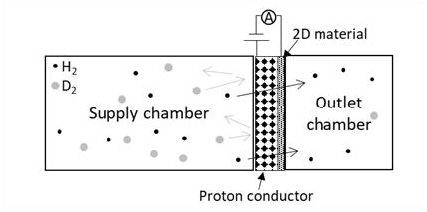Tech Briefs
Savannah River National Laboratory
2-D Material Hydrogen Isotope Separation Methods and Systems
Technology Overview
Savannah River National Laboratory has developed technology enabling the separation of hydrogen isotopes using a layer of graphene (or a similar 2-D material) on top of a proton conductor in an electro-chemical pumping configuration. In this process. The graphene or other 2-D material is selective to the hydrogen isotope, and the proton conductor combined with electrical power acts as a pump to move the isotopes selectively, concentrating the isotopes on opposite sides of the membrane by mass.

Benefits
- Moisture free
- Scalable
- Continuous processing
Applications and Industries
- Commercial fusion power will rely on Deuterium/Tritium fuels and necessitate very high reprocessing rates to maintain fuel purity in the plasma. This is one of very few technologies that could meet these demands, and eliminates some of the other concerns in existing technologies, such as cryo-distillation.
Description
This innovation provides a scalable membrane for separation of hydrogen isotopes in a continuous pro-cess, as compared to traditional batch process methods. The achievable separation factors are compet-itive with industry standard traditional techniques. Similar methods have been presented in the academic and patent literature with the notable limitation of relying on water as a transport aid. This technology works without water or moisture of any level (anhydrous), permitting the use in applications particularly sensitive to gas purity, including for fuel cycle functions in a commercial fusion power plant.
Intellectual Property
- This technology and methods for its use have been granted US Patent No. 11,433,353 “Hydrogen Isotope Separation and Systems.”
- This technology and related methods are available for licensing.
Partnering Opportunities
SRNL invites interested companies with proven capabilities in this area of expertise to develop commercial applications for this process under a cooperative research and development agreement (CRADA) or licensing agreement. Interested companies will be requested to submit a business plan setting forth company qualifications, strategies, activities, and milestones for commercializing this invention. Qualifications should include past experience at bringing similar products to market, reason-able schedule for product launch, sufficient manufacturing capacity, established distribution networks, and evidence of sufficient financial resources for product development and launch.
Download Tech Brief
Contact Information
Savannah River National Laboratory
E-mail: partnerships@srnl.doe.gov